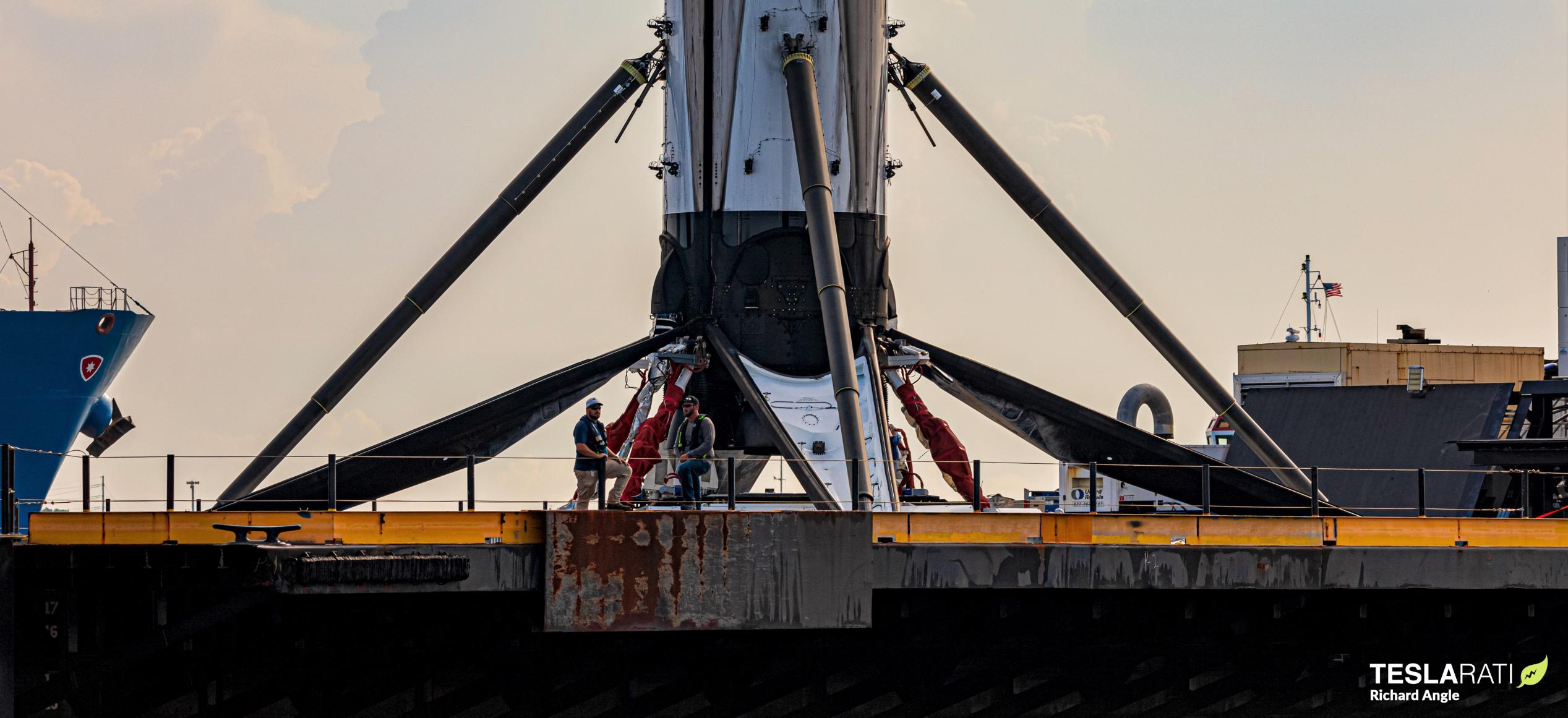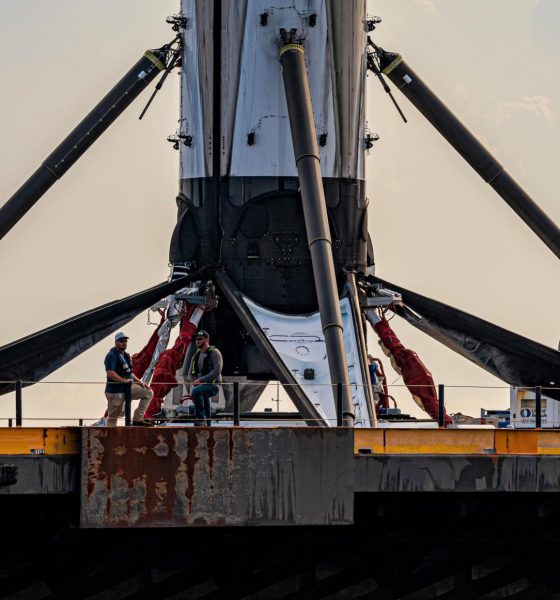

News
SpaceX Falcon 9 landing leg accidentally dropped during retraction attempt
SpaceX has accidentally dropped one of its newest Falcon 9 booster’s landing legs during a retraction attempt in Port Canaveral while crews worked to prepare the rocket for transport.
Falcon 9 booster B1060 safely arrived in Port Canaveral, Florida on July 4th after a flawless June 30th launch debut, delivering the US military’s GPS III SV03 navigation satellite to an accurate orbit and becoming the first SpaceX rocket to launch and land as part of an operational US military mission. The major landing milestone was supported by drone ship Just Read The Instructions (JRTI) as part of its second East Coast recovery mission ever after an ~8000 km (~5000 mi) journey from Los Angeles and months of slow and steady upgrades.
Thankfully, despite the mishap caught on camera by diligent, unofficial observers, things appeared to work out just fine for booster B1060 as crews threaded recovery operations between bouts of disruptive Florida weather.
Based on video of the accidental leg drop captured by US Launch Report on July 7th, the most obvious conclusion is that operators either failed to release tension on a winch line or some kind of hardware/software/sensor failure unintentionally over-stressed the line. Regardless, around the same time as Falcon 9 or its ground operators were likely commanding the landing leg latch closed, one or both of the lines attached to the top of the retracting leg snapped, causing it to very quickly redeploy as gravity pulled it back to earth.
Almost certainly by design, nobody was underneath the ~1000 kg (~2200 lb) landing leg during retraction, and a small stand used to prop up the leg for winch line installation seems to have been moved out of the line of fire as part of the process. As a result, when the leg was accidentally released, it simply fell onto drone ship JRTI’s flat, steel deck under its own weight. Most importantly, nobody was (visibly) injured or at risk of injury
The landing leg’s impact and aftershock looks undeniably harsh in the footage but the reality is that SpaceX has already performed almost identical tests (albeit intentionally) on recovered boosters while leg retraction was still in development. Captured in the video above, B1049’s September 2018 leg retraction and deployment test appeared to be marginally gentler than B1060’s accidental leg smack, and B1049 went on to complete four more orbital-class launches without issue. That still ignores the fact that Falcon 9’s landing legs are designed to withstand extremely rough landings of entire ~30 metric ton boosters traveling up to several meters per second (~5 mph) – vastly more force than a single landing leg can exert on itself with gravity as the only input.

Confirming those suspicions, SpaceX ultimately got back on the saddle after a few slight weather delays and successfully retracted all four of B1060’s landing legs without issue. The once-flown rocket was quickly broken over (referring to the process of lowering it horizontally) and installed on a custom transporter, which will soon move it from Port Canaveral to a nearby SpaceX hangar (likely Pad 39A’s) to prepare for its next launch.
Check out Teslarati’s Marketplace! We offer Tesla accessories, including for the Tesla Cybertruck and Tesla Model 3.

News
Tesla FSD fleet is nearing 7 billion total miles, including 2.5 billion city miles
As can be seen on Tesla’s official FSD webpage, vehicles equipped with the system have now navigated over 6.99 billion miles.

Tesla’s Full Self-Driving (Supervised) fleet is closing in on almost 7 billion total miles driven, as per data posted by the company on its official FSD webpage.
These figures hint at the massive scale of data fueling Tesla’s rapid FSD improvements, which have been quite notable as of late.
FSD mileage milestones
As can be seen on Tesla’s official FSD webpage, vehicles equipped with the system have now navigated over 6.99 billion miles. Tesla owner and avid FSD tester Whole Mars Catalog also shared a screenshot indicating that from the nearly 7 billion miles traveled by the FSD fleet, more than 2.5 billion miles were driven inside cities.
City miles are particularly valuable for complex urban scenarios like unprotected turns, pedestrian interactions, and traffic lights. This is also the difference-maker for FSD, as only complex solutions, such as Waymo’s self-driving taxis, operate similarly on inner-city streets. And even then, incidents such as the San Francisco blackouts have proven challenging for sensor-rich vehicles like Waymos.
Tesla’s data edge
Tesla has a number of advantages in the autonomous vehicle sector, one of which is the size of its fleet and the number of vehicles training FSD on real-world roads. Tesla’s nearly 7 billion FSD miles then allow the company to roll out updates that make its vehicles behave like they are being driven by experienced drivers, even if they are operating on their own.
So notable are Tesla’s improvements to FSD that NVIDIA Director of Robotics Jim Fan, after experiencing FSD v14, noted that the system is the first AI that passes what he described as a “Physical Turing Test.”
“Despite knowing exactly how robot learning works, I still find it magical watching the steering wheel turn by itself. First it feels surreal, next it becomes routine. Then, like the smartphone, taking it away actively hurts. This is how humanity gets rewired and glued to god-like technologies,” Fan wrote in a post on X.
News
Tesla starts showing how FSD will change lives in Europe
Local officials tested the system on narrow country roads and were impressed by FSD’s smooth, human-like driving, with some calling the service a game-changer for everyday life in areas that are far from urban centers.

Tesla has launched Europe’s first public shuttle service using Full Self-Driving (Supervised) in the rural Eifelkreis Bitburg-Prüm region of Germany, demonstrating how the technology can restore independence and mobility for people who struggle with limited transport options.
Local officials tested the system on narrow country roads and were impressed by FSD’s smooth, human-like driving, with some calling the service a game-changer for everyday life in areas that are far from urban centers.
Officials see real impact on rural residents
Arzfeld Mayor Johannes Kuhl and District Administrator Andreas Kruppert personally tested the Tesla shuttle service. This allowed them to see just how well FSD navigated winding lanes and rural roads confidently. Kruppert said, “Autonomous driving sounds like science fiction to many, but we simply see here that it works totally well in rural regions too.” Kuhl, for his part, also noted that FSD “feels like a very experienced driver.”
The pilot complements the area’s “Citizen Bus” program, which provides on-demand rides for elderly residents who can no longer drive themselves. Tesla Europe shared a video of a demonstration of the service, highlighting how FSD gives people their freedom back, even in places where public transport is not as prevalent.
What the Ministry for Economic Affairs and Transport says
Rhineland-Palatinate’s Minister Daniela Schmitt supported the project, praising the collaboration that made this “first of its kind in Europe” possible. As per the ministry, the rural rollout for the service shows FSD’s potential beyond major cities, and it delivers tangible benefits like grocery runs, doctor visits, and social connections for isolated residents.
“Reliable and flexible mobility is especially vital in rural areas. With the launch of a shuttle service using self-driving vehicles (FSD supervised) by Tesla in the Eifelkreis Bitburg-Prüm, an innovative pilot project is now getting underway that complements local community bus services. It is the first project of its kind in Europe.
“The result is a real gain for rural mobility: greater accessibility, more flexibility and tangible benefits for everyday life. A strong signal for innovation, cooperation and future-oriented mobility beyond urban centers,” the ministry wrote in a LinkedIn post.
News
Tesla China quietly posts Robotaxi-related job listing
Tesla China is currently seeking a Low Voltage Electrical Engineer to work on circuit board design for the company’s autonomous vehicles.

Tesla has posted a new job listing in Shanghai explicitly tied to its Robotaxi program, fueling speculation that the company is preparing to launch its dedicated autonomous ride-hailing service in China.
As noted in the listing, Tesla China is currently seeking a Low Voltage Electrical Engineer to work on circuit board design for the company’s autonomous vehicles.
Robotaxi-specific role
The listing, which was shared on social media platform X by industry watcher @tslaming, suggested that Tesla China is looking to fill the role urgently. The job listing itself specifically mentions that the person hired for the role will be working on the Low Voltage Hardware team, which would design the circuit boards that would serve as the nervous system of the Robotaxi.
Key tasks for the role, as indicated in the job listing, include collaboration with PCB layout, firmware, mechanical, program management, and validation teams, among other responsibilities. The role is based in Shanghai.
China Robotaxi launch
China represents a massive potential market for robotaxis, with its dense urban centers and supportive policies in select cities. Tesla has limited permission to roll out FSD in the country, though despite this, its vehicles have been hailed as among the best in the market when it comes to autonomous features. So far, at least, it appears that China supports Tesla’s FSD and Robotaxi rollout.
This was hinted at in November, when Tesla brought the Cybercab to the 8th China International Import Expo (CIIE) in Shanghai, marking the first time that the autonomous two-seater was brought to the Asia-Pacific region. The vehicle, despite not having a release date in China, received a significant amount of interest among the event’s attendees.








